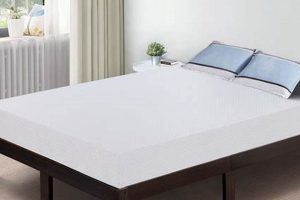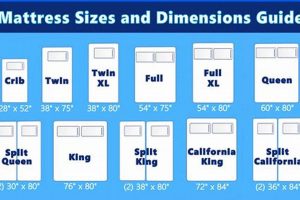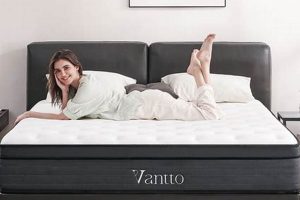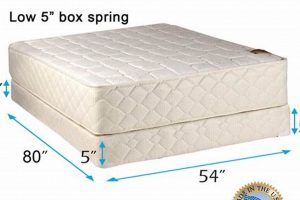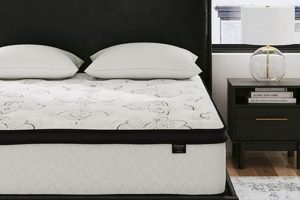A specific size of sleeping surface designed for recreational vehicles, measuring approximately 53 inches wide by 75 inches long, offers a compact solution for sleeping within the confines of a camper, motorhome, or travel trailer. This dimension is typically chosen to maximize available space while still providing adequate room for one or two occupants. Examples include memory foam, innerspring, and latex options engineered to withstand the rigors of travel.
The implementation of appropriately sized bedding is critical for ensuring restful sleep during travel and recreation. Its availability addresses the need for comfort and space efficiency within mobile living environments. Historically, specialized sizes have evolved to accommodate the unique dimensional constraints inherent in RV design, allowing manufacturers to optimize interior layouts and deliver a comfortable experience to owners.
Subsequent sections will delve into the diverse materials, construction methods, factors influencing purchase decisions, and maintenance practices relevant to selecting and maintaining appropriately sized mattresses for recreational vehicles.
Essential Considerations for RV Full Mattress Selection
The selection of a recreational vehicle mattress is crucial for comfort and sleep quality during travel. The following considerations are vital to making an informed decision.
Tip 1: Measure the Available Space: Precisely measure the dimensions of the designated sleeping area within the RV. Discrepancies between the stated size and the actual space can lead to ill-fitting bedding and reduced comfort.
Tip 2: Evaluate Mattress Materials: Consider the properties of different materials, such as memory foam, latex, and innerspring. Memory foam conforms to the body, latex offers breathability and support, and innerspring provides a more traditional feel. The ideal choice depends on individual preferences and needs.
Tip 3: Assess Firmness Level: Mattress firmness impacts spinal alignment and comfort. Individuals with back pain may benefit from a firmer option, while side sleepers often prefer a softer surface.
Tip 4: Consider Mattress Thickness: The thickness of the mattress influences its support and overall height. Thicker mattresses generally offer more cushioning, but may also reduce headroom within the RV.
Tip 5: Review Weight Considerations: The weight of the mattress contributes to the overall payload of the RV. Opting for lighter materials can help to optimize fuel efficiency and maintain safe operating parameters.
Tip 6: Check for Certifications: Look for certifications such as CertiPUR-US, which indicates that the mattress has been tested for harmful chemicals and emissions. This ensures the safety and health of the user.
Tip 7: Consider Motion Isolation: If the sleeping area will be shared, motion isolation is an important feature. Mattresses with good motion isolation minimize the transfer of movement, reducing sleep disturbances.
Making informed selections can significantly enhance the comfort and enjoyment of time spent in a recreational vehicle.
The subsequent section will provide a comprehensive overview of cleaning and maintenance practices.
1. Dimensions
The dimensions of a recreational vehicle sleeping surface are critically intertwined with its functionality and suitability. Precise measurements are not merely a specification; they dictate whether the bedding will physically fit within the designated sleeping area. A miscalculation can result in the inability to properly install the mattress, compromising comfort and usability of the space. For example, if the specified length exceeds the available space, the door may not close or walkways could be obstructed. Conversely, dimensions that are too small leave unused space, reducing the overall usable area within the RV.
The impact of correct dimensions extends beyond mere fit. They influence the overall layout and flow within the RV. A properly sized mattress allows for adequate space for movement around the bed, facilitating access to storage compartments and other features. Manufacturers design RV interiors with specific bedding dimensions in mind; deviations from these dimensions can disrupt the intended design and functionality. Furthermore, custom-sized mattresses are often required in older or uniquely designed RVs, underscoring the importance of accurate measurement and dimensional precision.
In summary, the dimensions of recreational vehicle mattresses are fundamental to their successful integration and utilization. Accurate measurement and adherence to specified dimensions are essential for ensuring a comfortable, functional, and safe mobile living environment. Failure to consider this element introduces practical challenges and detracts from the overall RV experience.
2. Material Composition
Material composition is a determining factor in the performance, longevity, and comfort of recreational vehicle bedding. The selected materials directly impact weight, breathability, support, and resistance to environmental factors inherent in RV usage.
- Memory Foam
Memory foam, typically polyurethane-based, conforms to the body’s contours, providing pressure relief and motion isolation. However, memory foam can retain heat, potentially causing discomfort in warmer climates. Higher density memory foam offers increased support and durability, but at a greater weight, impacting fuel efficiency and payload capacity.
- Innerspring Coils
Innerspring mattresses utilize a network of metal coils to provide support. The coil gauge and configuration influence firmness and responsiveness. While offering a more traditional feel and better airflow than memory foam, innerspring mattresses can be heavier and may transmit motion more readily, potentially disrupting sleep.
- Latex Foam
Latex foam, derived from natural or synthetic rubber, presents a balance of support, breathability, and durability. Natural latex is hypoallergenic and resistant to dust mites, making it a suitable option for individuals with sensitivities. Latex exhibits a bouncier feel compared to memory foam and often commands a higher price point.
- Hybrid Constructions
Hybrid mattresses combine elements of different material types, such as memory foam comfort layers atop an innerspring or latex support core. This construction aims to leverage the benefits of each material, offering a customized blend of support, comfort, and temperature regulation. Hybrid designs, however, may introduce complexity in terms of weight and overall cost.
The interplay between these materials dictates the overall performance of the RV mattress. Selecting materials that align with individual needs and usage patterns within the recreational vehicle environment is crucial for optimizing comfort and ensuring prolonged product lifespan. Variations in construction techniques and material quality further contribute to the diverse range of options available. Careful attention to material composition facilitates an informed purchase decision that maximizes long-term value.
3. Firmness Options
The selection of an appropriate firmness level for recreational vehicle mattresses is a critical determinant of sleep quality and overall comfort. Given the confined sleeping spaces and potential for prolonged use, aligning mattress firmness with individual physiological needs is essential.
- Spinal Alignment and Support
Mattress firmness directly impacts spinal alignment during sleep. A mattress that is too soft may cause excessive sinkage, leading to spinal misalignment and potential back pain. Conversely, a mattress that is too firm may create pressure points, particularly at the shoulders and hips. The optimal firmness level supports the natural curvature of the spine, minimizing strain and promoting restful sleep. Examples include medium-firm mattresses for individuals who sleep on their back and softer mattresses for side sleepers.
- Weight Distribution and Pressure Relief
Firmness influences the distribution of body weight across the mattress surface. A firmer mattress provides more even weight distribution, reducing pressure on specific areas such as the hips and shoulders. Softer mattresses, while offering greater initial comfort, may lead to concentrated pressure points over time. Individuals with higher body mass may benefit from firmer mattresses to ensure adequate support and prevent excessive sinkage. The choice between pressure relief and support dictates the perceived comfort and minimizes sleep disturbances.
- Sleeping Position Considerations
Preferred sleeping position directly correlates with optimal mattress firmness. Side sleepers typically require a softer surface to allow for shoulder and hip compression, minimizing pressure points. Back sleepers often benefit from a medium-firm mattress to maintain spinal alignment. Stomach sleepers may require a firmer mattress to prevent excessive arching of the lower back. Accommodating the individual’s typical sleeping posture ensures the most restful and supportive sleep experience within the constraints of an RV.
- Durability and Longevity
The firmness of the mattress can influence its long-term durability. Softer mattresses may exhibit greater compression and degradation over time, particularly with consistent use. Firmer mattresses generally maintain their shape and support for a longer period, offering increased longevity. The selection of a mattress with a firmness level that balances comfort with structural integrity ensures a prolonged lifespan and reduces the need for frequent replacement, an important consideration within the mobile environment of a recreational vehicle.
In summary, firmness is not a singular attribute but rather a confluence of factors intricately linked to individual physiology, preferred sleeping position, and long-term durability. Within the context of recreational vehicles, carefully considering the firmness of a mattress tailored to the specific needs of the user becomes paramount to maximizing the comfort and restorative benefits of sleep.
4. Weight Consideration
Weight consideration is a paramount factor in the selection of recreational vehicle mattresses. The overall weight of the vehicle directly influences fuel efficiency, handling characteristics, and adherence to permissible weight limits outlined by manufacturers and regulatory bodies. An RV mattress contributes to the total payload, necessitating careful attention to its weight specifications.
- Fuel Efficiency Impact
Increased weight directly reduces fuel efficiency. Heavier mattresses add to the total load, requiring more energy to propel the vehicle. This translates to higher fuel consumption over time. Selecting lighter materials, such as certain types of foam or strategically designed innerspring systems, can mitigate this effect. For example, replacing a heavy innerspring mattress with a lighter memory foam or latex alternative can yield noticeable improvements in fuel economy, especially during extended travel.
- Handling and Stability
Excessive weight impacts the handling and stability of the RV. A heavier mattress, particularly if located high within the vehicle, can raise the center of gravity, making the RV more susceptible to swaying and instability, especially during crosswinds or sudden maneuvers. Distributed weight is preferable to concentrated weight. A lighter mattress contributes to better overall weight distribution, enhancing stability and improving the driving experience.
- Adherence to Weight Limits
Recreational vehicles have strict weight limits, including Gross Vehicle Weight Rating (GVWR) and axle weight ratings. Exceeding these limits poses safety risks, potentially leading to mechanical failures, reduced braking performance, and increased risk of accidents. A heavy mattress contributes to the risk of exceeding these limits, particularly when combined with other onboard equipment and personal belongings. Compliance with weight regulations is critical for safe operation and legal compliance.
- Material Weight Variations
Different mattress materials exhibit significant variations in weight. Traditional innerspring mattresses tend to be heavier than foam-based alternatives due to the presence of metal coils. High-density memory foam can also be relatively heavy, whereas latex foam and lighter-density memory foams offer weight advantages. Hybrid mattresses, which combine multiple materials, present a spectrum of weight options depending on the specific construction and materials utilized. Material selection directly influences the overall weight contribution of the mattress.
The selection of a recreational vehicle sleeping surface necessitates careful assessment of weight specifications. Overlooking this element can negatively impact fuel consumption, vehicle handling, and adherence to critical weight restrictions. Prioritizing lighter materials and optimized construction techniques contributes to a safer, more efficient, and more enjoyable RV travel experience. Failing to address weight considerations introduces potential safety hazards and compromises the operational parameters of the recreational vehicle.
5. Space Optimization
In recreational vehicles, spatial constraints necessitate careful consideration of every component, including the sleeping surface. The selection of a properly sized RV full mattress directly impacts the efficient use of available interior volume. An oversized mattress impedes movement, restricts access to storage, and can negate the utility of surrounding areas. Conversely, a correctly sized mattress maximizes sleeping area while preserving functionality. The dimensions of the bed become integral to the overall design and usability of the RV’s living space.
Examples of space optimization strategies related to RV full mattresses include folding or hinged designs that convert sleeping areas into daytime seating or storage. Custom mattress shapes conform to irregular floor plans, exploiting otherwise unusable areas. Further, thinner mattress profiles, while potentially sacrificing some comfort, can increase headroom and facilitate easier access to overhead compartments. The choice of mattress dimensions and configuration involves a trade-off between sleeping comfort and efficient utilization of the confined RV interior.
In summary, space optimization is not merely a peripheral concern but a central determinant in RV full mattress selection. The mattress’s dimensions and configuration directly influence the vehicle’s liveability and functionality. Prioritizing space efficiency, through strategic design choices and careful measurement, maximizes the available interior volume and enhances the overall RV experience.
Frequently Asked Questions About Recreational Vehicle Full Mattresses
The following addresses common inquiries regarding recreational vehicle full mattresses, providing clear and concise information for potential purchasers and current owners.
Question 1: What defines a recreational vehicle full mattress?
A recreational vehicle full mattress typically measures approximately 53 inches wide by 75 inches long, designed to fit within the confines of a camper, motorhome, or travel trailer. Dimensions may vary slightly depending on the manufacturer.
Question 2: Are standard residential mattresses suitable for recreational vehicles?
Standard residential mattresses may not be appropriate due to size limitations or weight constraints within recreational vehicles. Specialized options are designed to optimize space and minimize weight, enhancing vehicle performance and interior usability.
Question 3: What materials are commonly used in recreational vehicle full mattresses?
Common materials include memory foam, innerspring coils, and latex foam. Each offers distinct properties regarding comfort, support, breathability, and weight. Hybrid constructions combining these materials are also prevalent.
Question 4: How does mattress weight impact recreational vehicle performance?
Mattress weight contributes to the overall payload of the recreational vehicle, influencing fuel efficiency, handling characteristics, and adherence to weight limits. Lighter materials are generally preferable to minimize these impacts.
Question 5: What firmness level is recommended for recreational vehicle full mattresses?
The recommended firmness level depends on individual preferences, sleeping position, and physiological needs. Considerations include spinal alignment, pressure relief, and weight distribution. Personal testing is advised when possible.
Question 6: How should a recreational vehicle full mattress be maintained?
Regular cleaning, vacuuming, and the use of mattress protectors are recommended to maintain hygiene and extend the mattress lifespan. Rotation or flipping of the mattress, if applicable, can promote even wear.
Understanding the nuances of recreational vehicle full mattresses is critical for making an informed purchase and ensuring a comfortable and safe travel experience.
The subsequent section will explore potential upgrades and accessories.
RV Full Mattress
This exploration has emphasized that the selection of an RV full mattress is not merely a matter of comfort, but a critical decision impacting space utilization, vehicle performance, and occupant well-being. Dimensional accuracy, material properties, firmness selection, and weight considerations collectively determine the suitability of the sleeping surface for the rigors of mobile living.
The informed selection, proper maintenance, and strategic upgrade of an RV full mattress are investments in the safety, efficiency, and enjoyment of the recreational vehicle lifestyle. Continued adherence to best practices will ensure optimal performance and contribute significantly to the overall travel experience.


